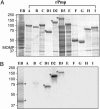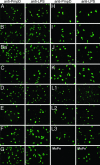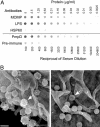Chlamydia trachomatis polymorphic membrane protein D is a species-common pan-neutralizing antigen
- PMID: 16446444
- PMCID: PMC1413641
- DOI: 10.1073/pnas.0508983103
Chlamydia trachomatis polymorphic membrane protein D is a species-common pan-neutralizing antigen
Abstract
Infections caused by the obligate intracellular pathogen Chlamydia trachomatis have a marked impact on human health. C. trachomatis serovariants are the leading cause of bacterial sexually transmitted disease and infectious preventable blindness. Despite decades of effort, there is no practical vaccine against C. trachomatis diseases. Here we report that all C. trachomatis reference serotypes responsible for sexually transmitted disease and blinding trachoma synthesize a highly conserved surface-exposed antigen termed polymorphic membrane protein D (PmpD). We show that Ab specific to PmpD are neutralizing in vitro. We also present evidence that Ab against serovariable-neutralizing targets, such as the major outer membrane protein, block PmpD neutralization. This finding suggests that a decoy-like immune evasion strategy may be active in vivo whereby immunodominant type-specific surface antigens block the neutralizing ability of species-common PmpD Ab. Collectively, these results show that PmpD is a previously uncharacterized C. trachomatis species-common pan-neutralizing target. Moreover, a vaccine protocol using recombinant PmpD to elicit neutralizing Ab in the absence of immunodominant type-specific Ab might be highly efficacious and surpass the level of protection achieved through natural immunity.
Conflict of interest statement
Conflict of interest statement: No conflicts declared.
Figures






Similar articles
-
Chlamydia trachomatis polymorphic membrane protein D is an oligomeric autotransporter with a higher-order structure.Infect Immun. 2009 Jan;77(1):508-16. doi: 10.1128/IAI.01173-08. Epub 2008 Nov 10. Infect Immun. 2009. PMID: 19001072 Free PMC article.
-
Poliovirus hybrids expressing neutralization epitopes from variable domains I and IV of the major outer membrane protein of Chlamydia trachomatis elicit broadly cross-reactive C. trachomatis-neutralizing antibodies.Infect Immun. 1995 Mar;63(3):1116-21. doi: 10.1128/iai.63.3.1116-1121.1995. Infect Immun. 1995. PMID: 7532625 Free PMC article.
-
Chlamydia trachomatis polymorphic membrane protein D is a virulence factor involved in early host-cell interactions.Infect Immun. 2014 Jul;82(7):2756-62. doi: 10.1128/IAI.01686-14. Epub 2014 Apr 14. Infect Immun. 2014. PMID: 24733093 Free PMC article.
-
Towards a Chlamydia trachomatis vaccine: how close are we?Future Microbiol. 2010 Dec;5(12):1833-56. doi: 10.2217/fmb.10.148. Future Microbiol. 2010. PMID: 21155665 Review.
-
Molecular pathogenesis of Chlamydia trachomatis.Front Cell Infect Microbiol. 2023 Oct 18;13:1281823. doi: 10.3389/fcimb.2023.1281823. eCollection 2023. Front Cell Infect Microbiol. 2023. PMID: 37920447 Free PMC article. Review.
Cited by
-
The Chlamydia pneumoniae Adhesin Pmp21 Forms Oligomers with Adhesive Properties.J Biol Chem. 2016 Oct 21;291(43):22806-22818. doi: 10.1074/jbc.M116.728915. Epub 2016 Aug 22. J Biol Chem. 2016. PMID: 27551038 Free PMC article.
-
Route of Vaccine Administration Influences the Impact of Fms-Like Tyrosine Kinase 3 Ligand (Flt3L) on Chlamydial-Specific Protective Immune Responses.Front Immunol. 2019 Jul 4;10:1577. doi: 10.3389/fimmu.2019.01577. eCollection 2019. Front Immunol. 2019. PMID: 31333682 Free PMC article.
-
Development of Transposon Mutagenesis for Chlamydia muridarum.J Bacteriol. 2019 Nov 5;201(23):e00366-19. doi: 10.1128/JB.00366-19. Print 2019 Dec 1. J Bacteriol. 2019. PMID: 31501283 Free PMC article.
-
Transcriptional analysis of in vitro expression patterns of Chlamydophila abortus polymorphic outer membrane proteins during the chlamydial developmental cycle.Vet Res. 2009 Sep-Oct;40(5):47. doi: 10.1051/vetres/2009030. Epub 2009 May 21. Vet Res. 2009. PMID: 19454212 Free PMC article.
-
Comparative Genome Analysis of 33 Chlamydia Strains Reveals Characteristic Features of Chlamydia Psittaci and Closely Related Species.Pathogens. 2020 Oct 28;9(11):899. doi: 10.3390/pathogens9110899. Pathogens. 2020. PMID: 33126635 Free PMC article.
References
-
- Division of STD Prevention. Sexually Transmitted Disease Surveillance 1997 (Centers Dis. Control Prev., Atlanta) 1998.
-
- World Health Organization. Global Prevalence and Incidence of Selected Curable Sexually Transmitted Infections: Overview and Estimates. Geneva: World Health Org.; 2001. pp. 1–43.
-
- Westrom L., Joesoef R., Reynolds G., Hagdu A., Thompson S. E. Sex. Transm. Dis. 1992;19:185–192. - PubMed
Publication types
MeSH terms
Substances
Grants and funding
LinkOut - more resources
Full Text Sources
Other Literature Sources

